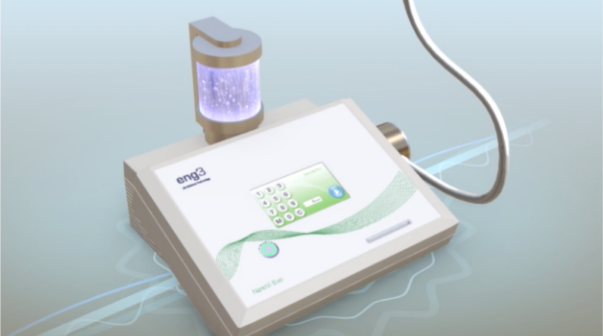Preserving Enzymes with Infrared-Treated Humid Air: A New Frontier in Biophysics
Read the full publication here.
The stability of enzymes under stress conditions—such as heat, oxidation, and chemical denaturation—is crucial in both biological systems and biotechnological applications. A recent study published in the International Journal of Molecular Sciences introduces an innovative approach using infrared (IR)-treated humid air, also known as Coherent Humidification (CoHu), to mitigate enzyme inactivation.
The Intervention: CoHu via Infrared-Irradiated Humidified Air
Instead of applying infrared light directly to water or protein solutions, this study employed humid air containing microdroplets of pure distilled water, irradiated with infrared energy at specific wavelengths. This treated airstream, termed CoHu, was produced using the NanoVi® device (Eng3 Corporation, Seattle, WA, USA), which emits IR radiation to induce changes in the physicochemical properties of the microdroplets.
Three key factors justified this method:
Better Heat Dissipation – Microdroplets dissipate heat more rapidly than bulk water.
Higher IR Absorption – Water vapor absorbs infrared energy more effectively than liquid water.
Formation of Exclusion Zones (EZs) – Microdroplets have larger surface areas, favoring the generation of EZs, structured layers of water with unique properties.
The authors hypothesize that these exclusion zones, energized by IR radiation, contribute to preserving enzyme structure and function under damaging conditions.
Study Results: CoHu Preserves Enzyme Activity Under Stress
The enzymatic activity of horseradish peroxidase (HRP), alkaline phosphatase (ALP), and catalase (CAT) was evaluated under different stress conditions, comparing CoHu-treated samples with controls.
Heat Inactivation:
HRP activity was partially preserved with CoHu treatment (24.9% pre-treatment; 14.9% post-treatment).
ALP activity was enhanced by 130% after heat inactivation and CoHu treatment.
CAT showed partial recovery of activity (+17.8% pre-; +13.4% post-treatment).
Oxidative Stress:
HRP preserved 45.3% activity (pre) and 42.4% (post).
ALP showed moderate recovery (18.1% pre; 19.8% post).
CAT showed increased H₂O₂ consumption post-treatment, indicating enzyme reactivation.
Chemical Denaturation:
HRP activity was restored to 53.4% (pre) and 60.9% (post).
ALP recovered from 23.9% to 35.9% after CoHu exposure.
These findings suggest that CoHu can help restore enzymatic function after damage without altering the activity of enzymes under normal conditions.
Authors’ Conclusions and Hypothesis
The researchers concluded that infrared-treated humid air does not affect normal enzyme performance but significantly helps restore function after thermal, oxidative, or chemical damage. They propose that exclusion zone (EZ) water formed under IR influence may act as an energy reservoir and antioxidant system, stabilizing proteins by supplying electrons and reducing molecular entropy.
Citing Gerald Pollack’s work on EZ water, the authors suggest that CoHu may enhance the cellular environment by promoting optimal hydration states around proteins. However, they emphasize the need for further studies, especially in vivo, to confirm these hypotheses and explore potential biomedical applications.
Reference: Yablonskaya OI, Voeikov VL, Novikov KN, Buravleva EV, Menshov VA, Trofimov AV. Effect of Humid Air Exposed to IR Radiation on Enzyme Activity. Int J Mol Sci. 2022; 6;23(2):601. doi: 10.3390/ijms23020601.
